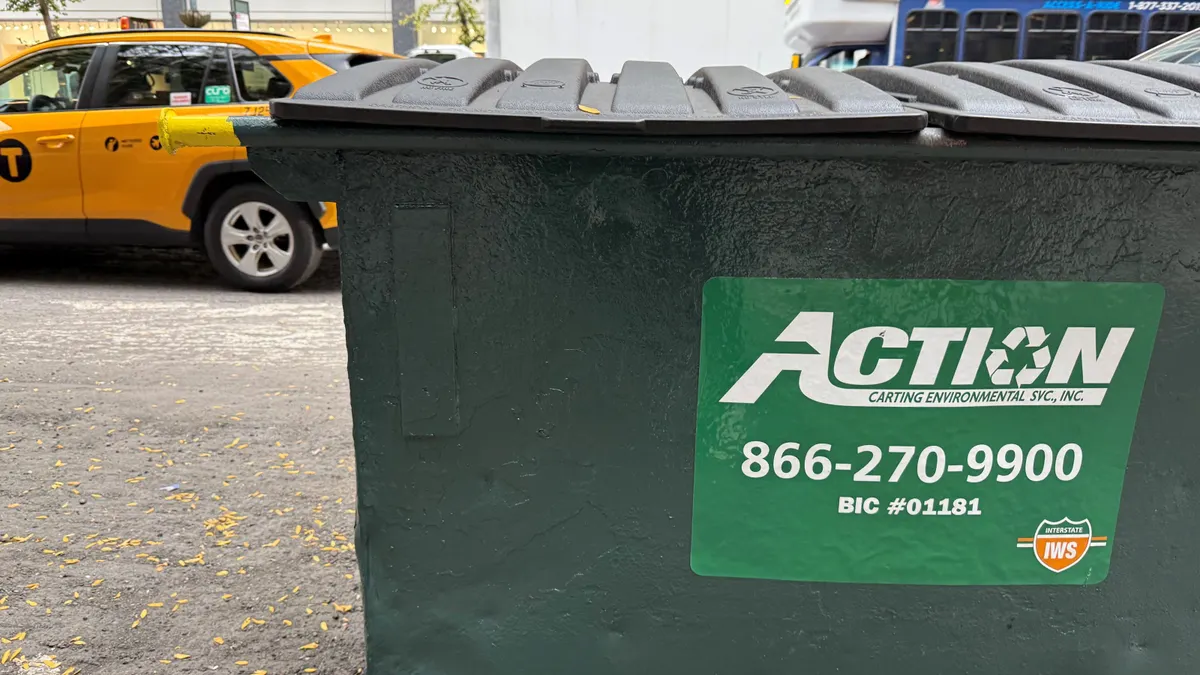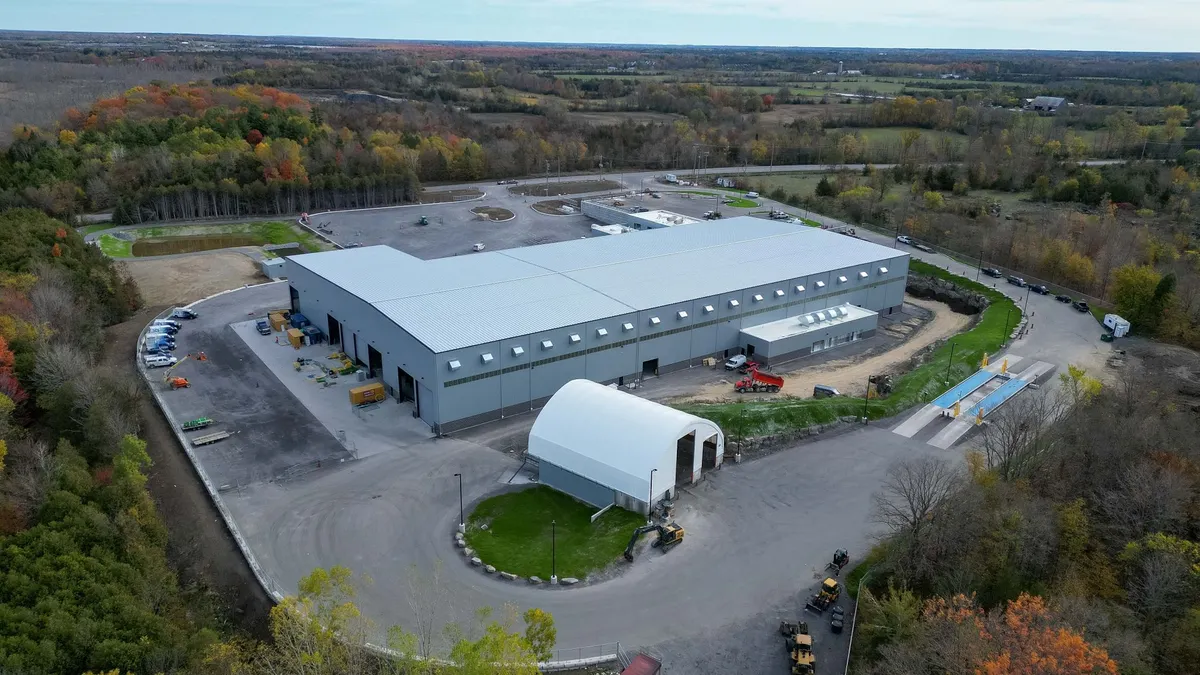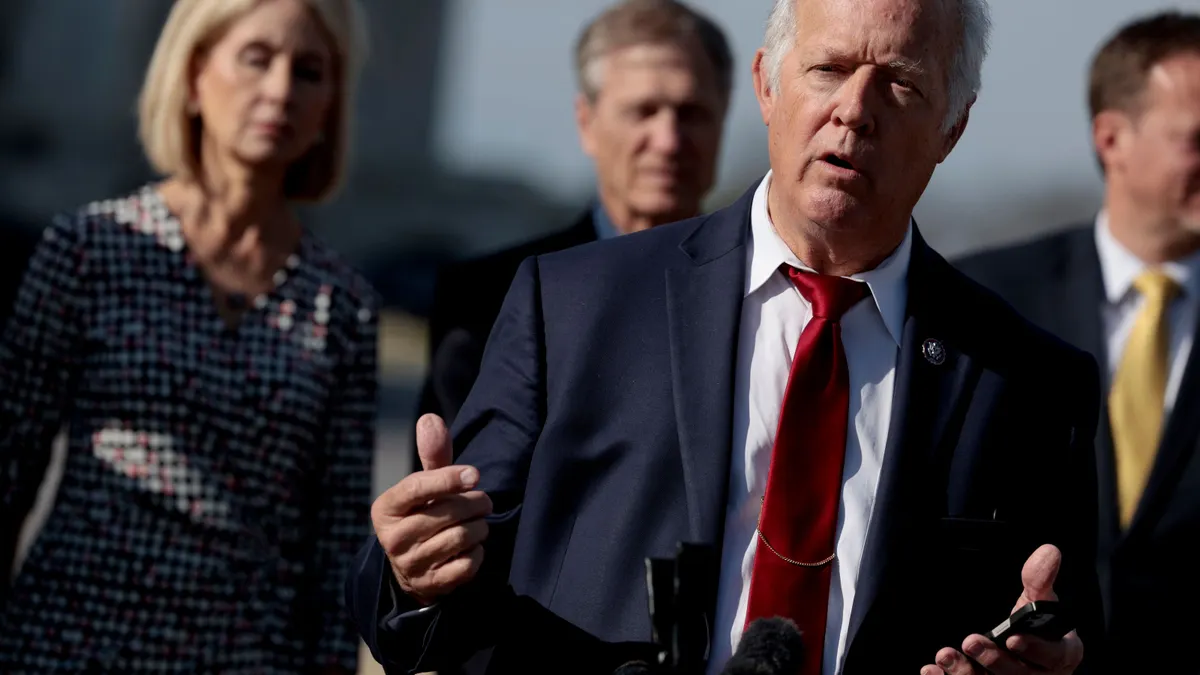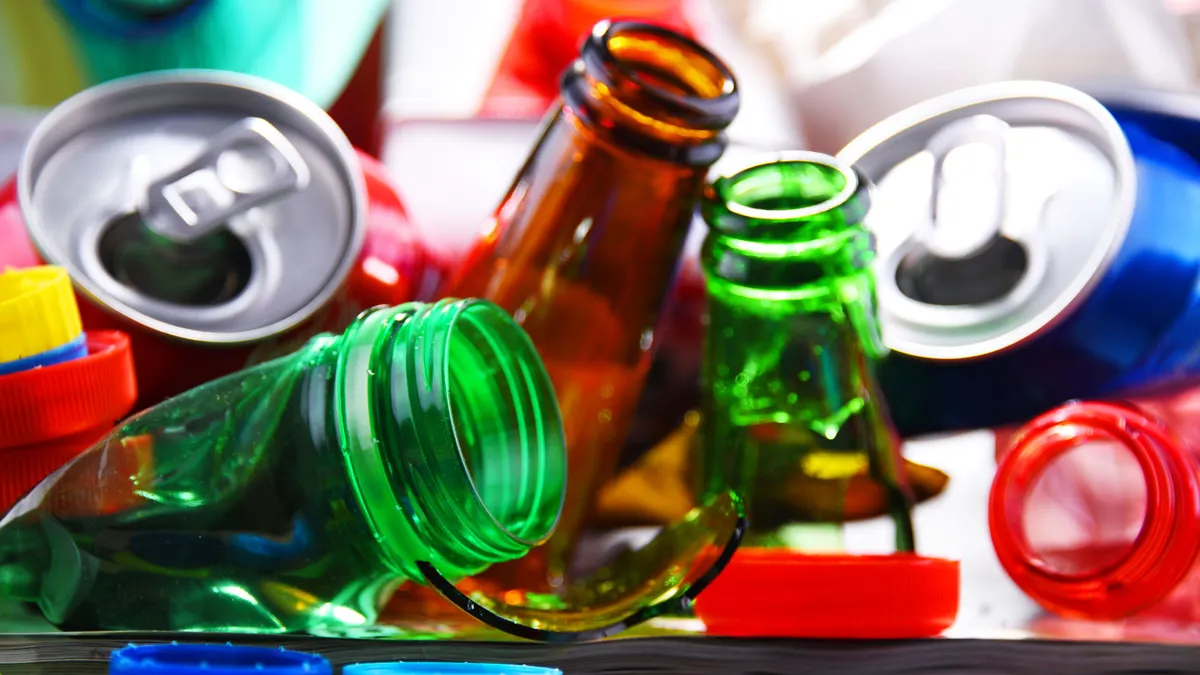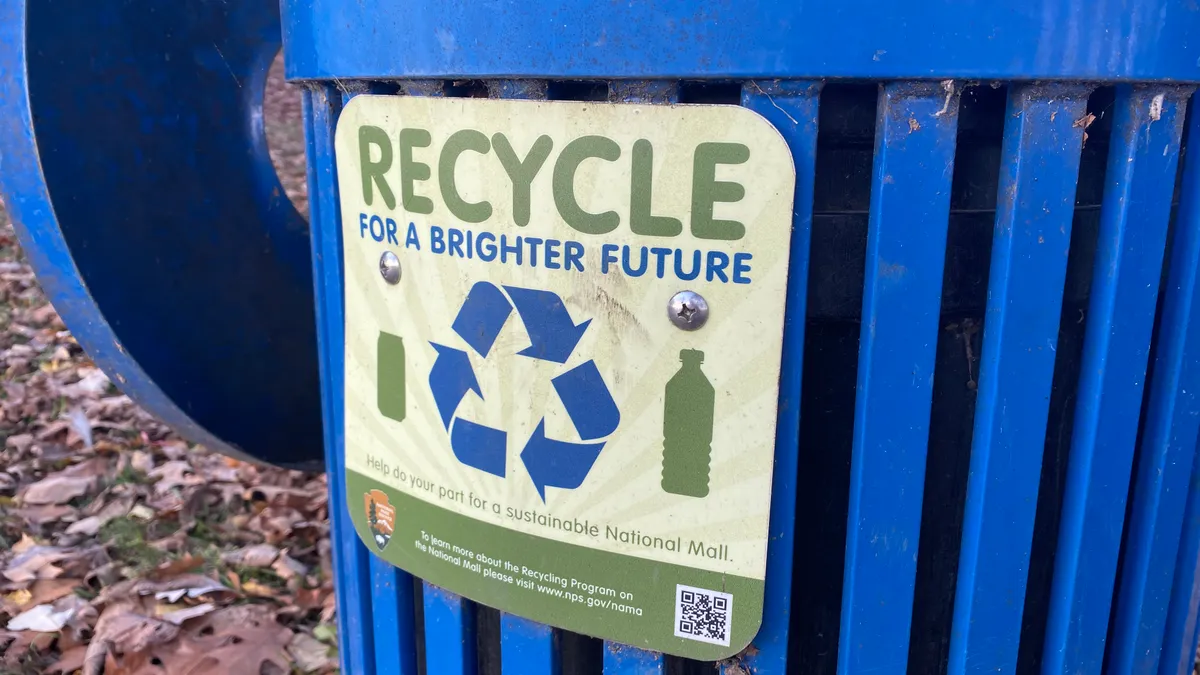If all goes well, this year's America Recycles Day may be remembered as the one where the national conversation began to coalesce around a collective vision.
Or it will go down as the height of choreographed symbolism.
Earlier this month, many of the recycling world's biggest names came together in Washington, D.C. to affirm the industry's economic and environmental importance at what was described as the first-ever EPA Recycling Summit. Forty-four people signed a voluntary pledge in a photo-op with Acting EPA Administrator Andrew Wheeler. Then, an even larger group gathered in a cavernous oak-paneled meeting room for two hours of discussion. A large map of the U.S., a relic of the building's former Interstate Commerce Commission days, loomed fittingly overhead.
The event carried the weight of historic import — yet for all the fanfare, it drew limited media coverage. Beyond a short piece the day after, Waste Dive has also struggled to evaluate the proceedings. As tempting as it's been to write this non-binding pledge off as more theater than substance, the obvious significance assigned to gathering stakeholders together warrants more attention than the event has so far received.
The range of financial, political, social and regulatory connections among those in attendance is vast. In a country that lacks a national recycling policy, the various stakeholders' individual sense of responsibility in addressing current issues will prove key to whether this EPA pledge yields any tangible results.
The EPA
The EPA's role in helping to address the many structural changes in recycling that have taken place over the past year or more has at times been unclear. Many career staff have continued to attend conferences and remain engaged in ongoing dialogue, but direct actions have been limited. This event was seen as an opportunity for the agency to showcase its intent to play a larger role, albeit more than a year after China's scrap import restrictions upended the conversation last summer.
Wheeler sat in the center of it all, flanked by Acting Assistant Administrator of the Office of Land and Emergency Management Barry Breen and nominee for the post Peter Wright, to set the agenda. In keeping with President Trump's proclamation and recent framing in the EPA's latest Facts & Figures report, he emphasized the economic angle first and foremost. Wheeler also touched on common points — commodity market shifts, public education challenges, aging infrastructure, inconsistent measurement standards — before making clear how far EPA's jurisdiction actually extended.
“The issues we face are of national significance and will require collective action to successfully address them," he said, reading from prepared remarks. “Our role at EPA is to help develop best practices, provide the data the public needs to monitor their recycling efforts and incentivize action through our programs and grants."
After about 20 minutes, Wheeler departed without taking questions or engaging in the dialogue.
The brands
Big name manufacturers have an interest in seeing their products recycled in order to maintain an image of environmental stewardship — and, in some cases, guarantee a steady stream of feedstock. However, they view themselves as only one part of the equation. Rather than an extended producer responsibility system for packaging, as exists in some other countries, they prefer a form of shared responsibility. A sizable chunk of that gets placed on the consumer.
The challenge there, as made clear at a morning session organized by Keep America Beautiful and Keurig Dr Pepper, is that even the most amenable consumers remain confused. Following a lecture on behavioral science, seven focus group participants shared their grievances and questions for about an hour as industry professionals listened.
While far from scientific, the range of comments showed how much work needs to be done if consumer education is considered the key to success. The most avid recyclers still admitted to being unsure of how the process worked, while others expressed outright distrust in the system.
“This is the first I’ve heard of the single stream recycling," said one.
“I love the environment as much as anybody, but I would still like to know what the purpose of all this is," said a self-proclaimed non-recycler. "It’s like we’re sheep.”
“You guys are making money and we’re sitting here going through all this effort," observed another occasional recycler.
During the EPA summit, Keep America Beautiful CEO Helen Lowman described this portion of the event as being the most compelling, reemphasizing the importance of consumer responsibility.
Others at the table representing companies that make the products in question struck a similar tone by taking various shares of responsibility upon themselves while still maintaining a healthy distance.
“Our consumers tell us one thing — and that is they look for us to give them sustainable products and packages," said Stephen Sikra, associate director of corporate R&D at Procter & Gamble. "While they’re buying our products because they want them to perform, they look to us to design it properly for proper recovery and proper recycling."
“Making it easy for customers is a very important step, and quite frankly it’s not easy enough right now. We have to make it easier as an industry and we have to design the right way and we have to tell the customer how to recycle in the right way," declared Zach Freeze, senior director of strategic initiatives for sustainability at Walmart.
“We know that packaging waste is a problem. It’s a global problem and we know our packages are contributing to that problem," said Ryan Guthrie, group director of federal government relations for Coca-Cola — which, like the others, has set its own future goals around packaging recyclability. Guthrie added that while his company is willing to invest significant marketing dollars to get the message out, responsibility would need to be shared by all in the room. "It’s good for our planet, it’s good for our communities, and frankly it’s good for business — and so we’re committed to it at Coca Cola."
The collectors and their customers
Recyclers — both public and private — struck a different tone. They have been steadfast in their insistence that recycling service needs a cost increase due to the modern logistics of collection and sorting. In municipalities that have "zero waste" or high diversion rate goals, those costs may become even higher.
“SWANA believes that the current market disruption caused by China’s waste import restriction imposes unique burdens on local governments, who are often stuck between vocal citizens that demand ever-increasing recycling goals and the practical reality of volatile commodity markets," said CEO David Biderman, adding that the organization "wants to move beyond pointing fingers at aspirational or confused citizens."
Later in the dialogue, Biderman also added, "Maybe we should stop thinking about chasing tons and we should be going after the right tons."
"China did not cause our market disruption, but it did expose a number of weaknesses in U.S. residential recycling, including a collection system that varies by community and is driven by local wishes instead of manufacturing demand," said ISRI President Robin Wiener.
The NWRA, representing private interests, took an even more direct line.
“I’ve heard a lot of the larger companies and entities in the room talk about making materials that are recyclable. Just because something is recyclable doesn't mean it has a market to be recycled," said CEO Darrell Smith. "It’s very commendable to make these products that can be recycled, but maybe try to work with the people that wind up with the stuff to try to find a market for it."
NWRA members Waste Management and Republic Services, the only two industry companies at the table, expressed similar sentiments — which echoed the messaging they've been delivering during earnings calls and conferences for the past year.
Brent Bell, Waste Management's vice president of recycling, listed off the standard statistics: an approximate average 25% contamination rate and the fact that 60% of what his company is currently collecting has no value. Republic's vice president of recycling, Pete Keller, emphasized the need to change municipal contract structures.
"Changing commodity markets, changing material streams, additional program recyclables — that’s the part of our business that’s broken," he said. "We’ve come to the realization very painfully that we can’t continue to live that way."
The question of what this financial pressure means for local governments was also front and center.
“We have recovered from crashes before and we can expect to recover again," said Southeast Recycling Development Council Executive Director Will Sagar, describing local governments as being at the "headwater of volatility." He added, "We need an intervention to provide stability for municipal collection programs and we have to approach the contamination problem."
The National Association of Counties, among others, expressed similar feelings. The Recycling Partnership, a corporate-backed nonprofit that assists state and local governments, expressed characteristic optimism while also emphasizing a sense of urgency.
“We can make measurable change between now and next year in those four areas. In fact, we have to. Communities cannot bear the cost burden of recycling alone. They look to the companies, to governments and to organizations like many of those in the room to help them — and help them we must," declared CEO Keefe Harrison. "And we must do it quickly, because if we do not, they will not survive this economic blip."
The back end
Also represented were a host of material-specific trade associations, investment groups and others that have a direct stake in what happens post-collection. They also had their own focal points, pushing for more clarity around infrastructure priorities and a new sense of how the conversation has been framed to date.
“There’s trillions of dollars in investment capital that could come into this sector that’s going into more linear models today and a lot of the capital is on the sidelines for a variety of reasons," said Bridget Croke, vice president of external affairs for Closed Loop Partners. “Investors don’t have a clear sense of the availability of good feedstock that is coming to bear."
“From an infrastructure perspective, we need to think about what is the future of packaging," said Sustainable Packaging Coalition Director Nina Goodrich. "We’re really focused on what we have today, and what we can recycle, but if we want to get ahead, and we want to lead, we need to work with those companies that are creating the future of packaging and understand how to create that infrastructure for tomorrow’s package."
"This is an exciting time to have this discussion, and I encourage flexibility and creativity as we think about the models that will take us into the future, [which] may not be the models that have brought us to where we are today," said Steve Russell, vice president of the American Chemistry Council's plastics division. “Nobody wants material to be wasted, nobody wants the environment contaminated by plastic or paper or aluminum or glass. We want to all do better."
The list went on, with further perspectives from paper, plastic, aluminum and other interests, before one penultimate comment brought a hint of skepticism to the proceedings.
"I think the one thing we are missing that is absolutely critical to our success is a shared vision of what the future looks like and why we want to get there. Not just how we get there," said Jeff Wooster, global sustainability director for Dow Packaging & Specialty Plastics. “We’ve got to come up with a shared vision around recycling that really inspires each and every one of our companies — and each and every one of our organizations, and governments around the country, and individual citizens — to really take part in this process if we really want it to be successful. We can’t just keep doing the same education programs and the same things that we’ve been doing for the last 15 years and expect a different result."
What happens next?
Those last remarks raise an evergreen question about recycling in the U.S. today. When it means so many different things to so many different people — who all have different stakes in making it work, and different definitions of what making it works means — how can true progress be measured? When curbside recycling — largely the focus of the event — is often viewed in terms of profit rather than public utility, who sets the conditions and who reaps the benefits? When policy authority is largely deferred to state and local governments — which have a wide range of capabilities and authority themselves — where does the EPA fit in? When programs or products fall through the cracks, who is the last line of defense to catch them in an open market system?
Some of these questions may be addressed in further meetings and calls planned around the four key action areas for the months ahead. The hope is to reassemble with happier results to report for America Recycles Day 2019. In the meantime, EPA's Barry Breen did his best to sum it all up as the event concluded.
“We hope that together among ourselves and with others who are interested in joining over the next several months, we can develop a national action plan. Will it be perfect? No. But do we have a chance to wait and do nothing? Absolutely not," said Breen. "Doing nothing is not an option, because everybody signed that sheet that says you’ve going to do something."






